10 Major Ports Of Scotland
Scotland is a developed country that is a part of the UK. It is a famous tourist destination with unmatched beauty, mountains, rivers, streams, beautiful countryside and modern cities.
It is a marine nation with a pleasant climate and several ports and harbours that serve its primary industries, including oil and gas, financial services, renewable energy etc.
In this article, let us look at the main drivers of Scotland’s economic growth; the 10 major ports of Scotland.
1. Aberdeen Harbour
Aberdeen Harbour is the main port facility for northeastern Scotland and a prominent marine support centre of Europe regarding offshore energies. Over 4 million tonnes of cargo were handled by the port in 2018. It has connections with nations on almost all continents, with major trade partners being Canada, Japan, Australia etc.
It is the main port of departure for cargoes destined for the Baltic region and Scandinavia, with key exports being granite, fertilisers and chemicals. It also caters to the oil and gas industry and deals with the highest volume of Platform Supply Vessel turnarounds in the United Kingdom.
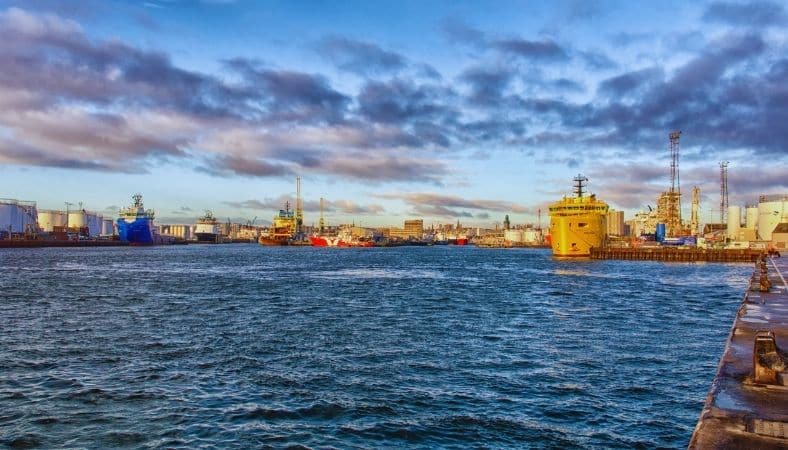
The port has played a vital role in Scottish trade and commerce for around 900 years. The new and expanded facility will create over 15,000 jobs and boost the country’s energy sector.
Offering the largest berthage in the country, Aberdeen is constantly evolving to support new businesses and provides logistics services to its customers.
The multimodal port is linked to Scotland’s main trunk roads and the railway network through the Waterloo Multimodal Terminal.
The port has several terminals for handling grains, project cargoes, general cargo, liquid and dry bulk, forest products, including wood pulp, manufactured items, food and beverages.
2. Grangemouth Port
Situated on the Firth of Forth river, the Forth Ports Grangemouth is the biggest petrochemical complex in Scotland and the country’s biggest port which handles approximately 9 million tonnes annually. It is also an important container-handling facility.
It has numerous general cargo, solid and liquid bulk terminals. The cargo that passes through this port represents 30% of the Scottish GDP, highlighting its role in the country’s economic growth. Its strategic location amidst the major cities of Edinburgh and Glasgow makes it the perfect place for logistics and distribution.
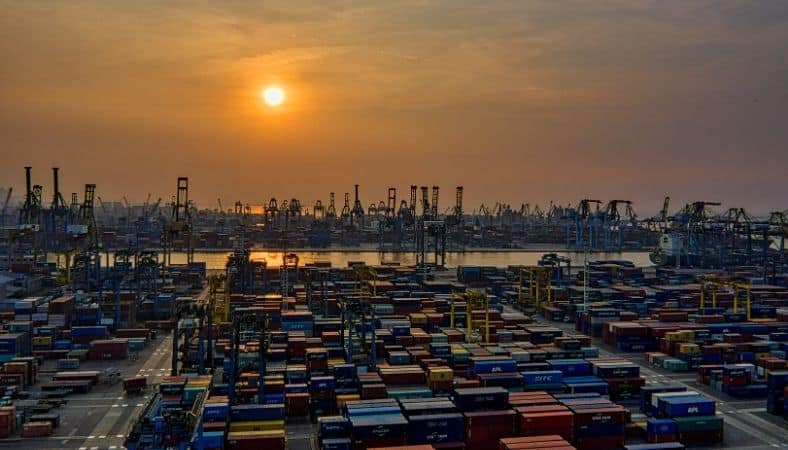
It is an integral part of the Supply Chain. It offers a gateway for the Scottish maritime industry by facilitating the flow of over £6 billion worth of commodities such as consumer products, food and beverage, machinery, oil, steel products, timber, equipment for the oil and gas sector, paper, automotive, containerised cargo etc. It also has the biggest container terminal in Scotland, handling about 250,000 TEUs annually.
The port provides seven weekly feeder services and is used by ten global shipping companies. It has upgraded infrastructure and 500,000 square feet of warehousing facilities. It is also well connected to the railway infrastructure.
3. Port of Dundee
Dundee Port is ideally located on the eastern coast of Scotland amidst Aberdeen and the Central Belt. It is the economic generator in Dundee city along with the Tayside area. The port is on the northern side of the River Tay estuary.
It is a modern port having 1600 metres of quayside and six operational berths. The port has 100,000 m3 of liquid storage and 150,000 tonnes of agripods storage. Apart from this, it also has an import grain drying facility and a decommissioning facility.
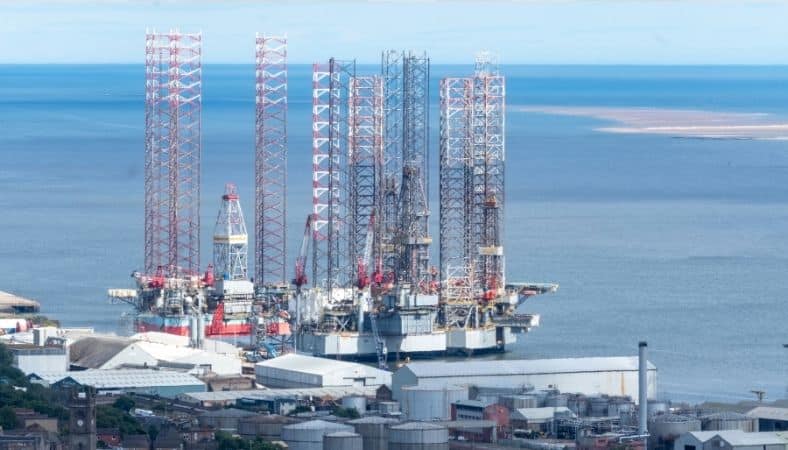
Dundee is perfectly positioned to serve the North Sea Oil and Gas Industry. It handles various kinds of oil and gas cargo like drilling equipment, oil rigs and support vessels. It is one of the biggest timber ports in the United Kingdom, dealing with timber mainly from Russia, the Baltic region and Scandinavia.
It also deals with grains, fertilisers, animal feed, steel, metal scrap, machinery etc. Lastly, Dundee is a famous destination for cruise ships and boasts modern facilities for welcoming guests to the beautiful city.
4. Leith Port
Scotland’s biggest enclosed deepwater port, Forth Ports Leith, can handle ships weighing up to 50,000 DWT. It is situated to the northeast of Edinburgh, on the southern bank of the Firth of Forth river, only three miles from the city centre.
It handles many types of cargo, such as grains, steel pipes, animal feed, and recycled items, and ensures that industries like food production, agriculture, and oil and gas can grow and thrive. The port handles about 1,500,000 tonnes of cargo and about 50 cruise ships annually.
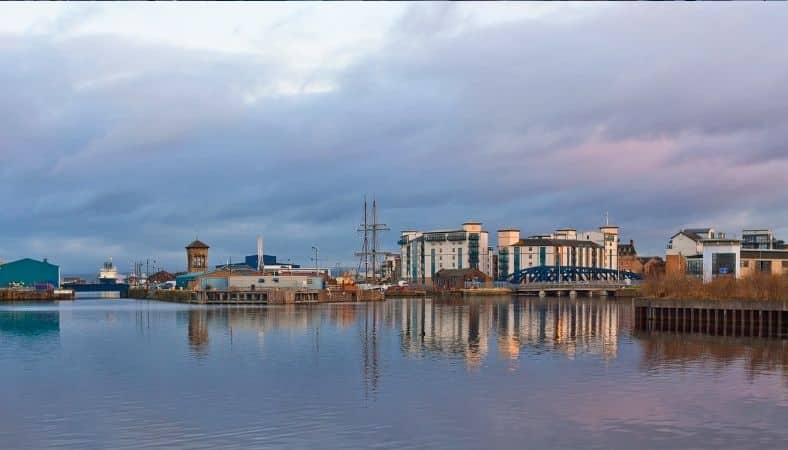
It has two dry docks and boasts the largest dry dock facility on Scotland’s eastern coast. It also has 20 operational berths and an expansive covered and open storage by the quayside. Anchorage is also available in the port.
Leith provides a 4700 m of quay that accommodates general cargo ships, bulk carriers, container carriers, tankers and RORO vessels. It also accommodates cruise ships and is home to the Royal Yacht Britannia.
5. Greenock Port
Greenock port lies on the southern bank of Clyde River near the Firth of Clyde. It is the main facility serving the city of Glasgow and comprises an ocean terminal and the James Watt Dock. It is one of the country’s leading container facilities and has a 16-hectare Ocean Terminal that efficiently handles around 100,000 TEUs annually.
Around 300,000 tonnes of cargo pass through Greenock every year.
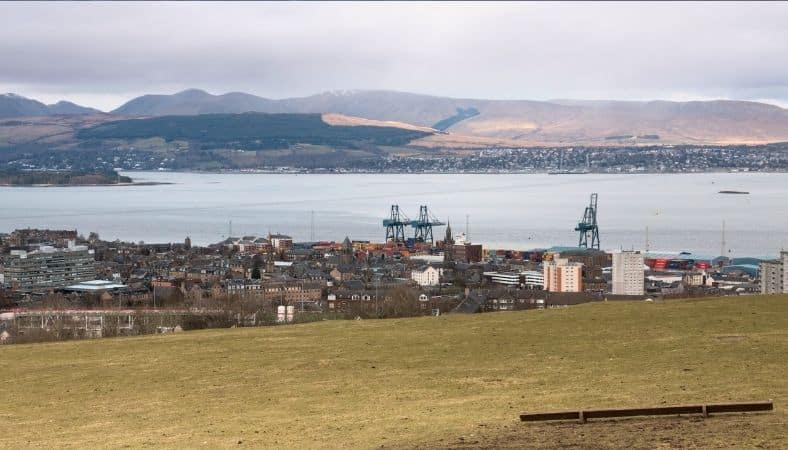
It also accommodates cruise ships and huge RORO vessels. It also welcomes one of the world’s most popular ocean liners, such as the QEII, constructed on the Clyde. Greenock is also a regular port of call in summer for the PS Waverley, the last paddle-steamer in the world.
Greenock has a long history of trading. It became famous as a fishing port in the 17th century and was known for the herring trade. In the 18th and 19th centuries, it became a hub of shipbuilding and a point of departure for emigrants. It was also known for oil-refining, pottery, glass and barrel making. Presently, it is a major container port and functions as a ferry port to the northern part of Ireland.
6. Rosyth Port
Rosyth is situated on the northern bank of the Firth of Forth on Scotland’s eastern coast. Earlier, it was a base of the Royal Navy, but today it hosts cruise liners and provides ferry services, linking Scotland with the other regions of the continent.
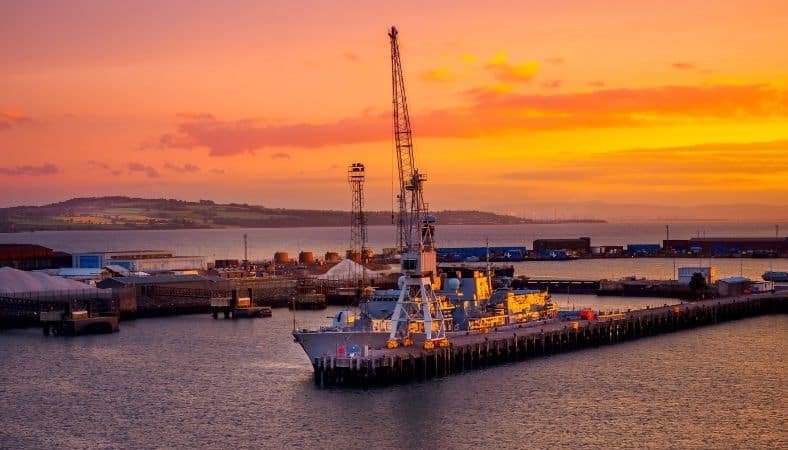
It does not have all the facilities for commercial shipping, and one needs to make special arrangements in advance. However, it does handle cargo of chemicals and forest products. Rosyth handles around 200,000 tonnes of bulk and packaged cargo each year.
Rosyth is a principal port which keeps the nation’s cargo moving. It is a centre for agricultural products, renewables, project cargo, manufacturing and oil and gas. Its ideal location has made it an important port of call for cruise liners, and it has grown manifold due to the timely investments which have transformed it into Scotland’s key turnaround hub.
7. Inverness Port
Situated about six nautical miles southwest of Chanonry Point in the Inverness Firth, this port is one of Scotland’s most well-sheltered natural harbours. It is an economic hub of the Highlands, which provides a main gateway for shipping companies in the north for exporting and importing a diverse range of cargo.
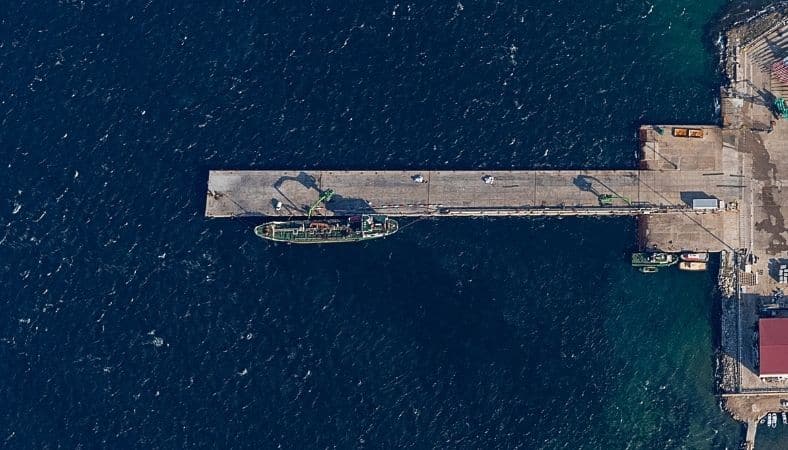
It has 650 m long quays, and a 5-hectare storage area is adjacent to them. Inverness handles imports of packaged timber, fuel oils, rock salt, paper pulp, grains, granite, roofing slates etc. Exports comprise potatoes, machinery, barley, woodchips, salmon smolts and so on. Around 400 ships and 1,000,000 tonnes of cargo are handled at the port annually.
The port is near the city centre and has witnessed growth and expansion. It trades with the UK, Baltics, Scandinavia and the European Union.
8. Port of Cromarty Firth
Located on the northeastern coast of Scotland, Cromarty Firth is a deepwater port which is also well-sheltered. It is in close proximity to the North Sea oilfields and is an important harbour for the oil and gas industry.
Apart from oil, another main commodity handled here is grain, while imports comprise coal, fertilisers, fishmeal and pipes. It has several berths and bulk cargo handling capabilities with quayside grabbing and a hook crane. It can accommodate ships weighing up to 50,000 DWT with a draft of 11 m.

The port has served the country for more than four decades and generated approximately £275 million annually for the economy. It has also become one of the most famous cruise ports by acting as a gateway to the highlands.
Also, it provides oilfield support services like the repairs, inspections, maintenance and conversions of semi-submersibles, drilling rigs and other production vessels. Around 2,860,000 tonnes of cargo and over 500 ships are handled at the port annually.
9. Port of Peterhead
Peterhead port is a deepwater facility on the Scottish mainland. It is near the main oil and gas fields of the central and northern parts of the North Sea. Its strategic location has made it a major support hub for servicing the offshore oil and gas sector and companies operating in the region.
Peterhead port has over three kilometres of the berthing area with depths of around 14 m. It provides quality services to other sectors like fisheries, renewables and leisure.
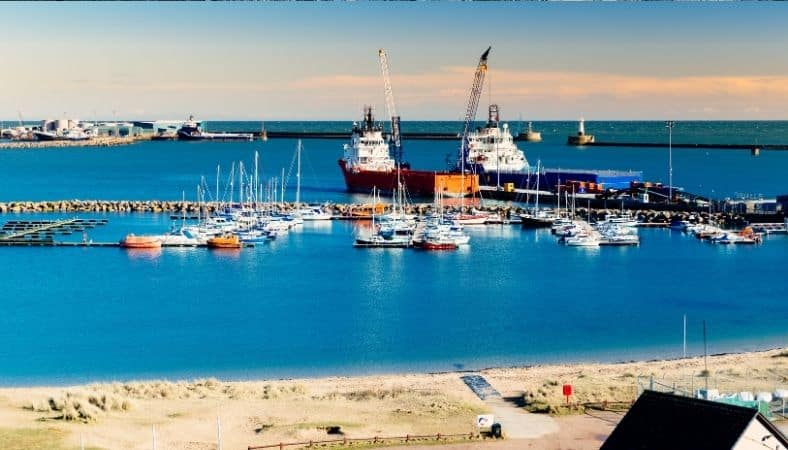
It is made of 11 different areas, namely the North Harbour, Port Henry Basin, Albert Quay, North Base, Merchant’s Quay, Princess Royal Jetty, Tanker Jetty, South Base, and Peterhead Marina etc.
It handles grains, coal, fertilisers, oil, aggregates, salt, palletised cargo, frozen fish, seafood and shellfish. It even has fish processing plants, cold storage etc. It can easily handle about 800,000 tonnes of cargo every year.
10. Scrabster Harbour
Scrabster lies at the western head of Thurso Bay on the northern coast of Scotland. It has around 400 metres of quayage that accommodate general cargo vessels, bulk cargo carriers, RORO and tanker ships.
Containers are moved in the port using conventional cranes. It also has 2 RORO ramp berths, the port provides international ferry services, and it gets quite busy during summer.
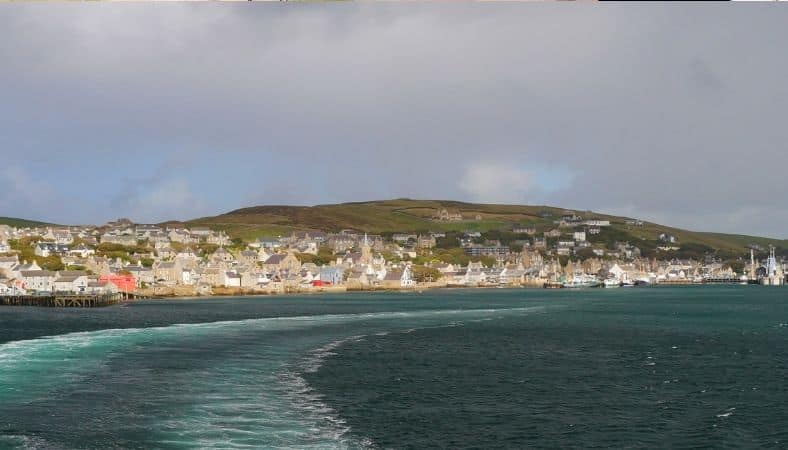
The port caters to many sectors, including oil and gas, fishing, cruises, renewables etc. It has many facilities and operates all year round, handling about 250,000 tonnes of cargo annually. It is also known as UK’s one of the top whitefish and shellfish landing harbours.
It has a rich history, and the Scrabster Harbour has offered deep water anchorage to seafarers since the times of the Vikings’ longboats. Due to its advantageous position, it has become a gateway to the northern regions of Orkney, Scandinavia, Shetland and Faroes. It has become home to a fishing fleet and also some ferries. It is a famous port of call for cruises and supports the offshore oil industry.
You might also like to read-
- 10 Arctic Ocean Facts You Might Not Know
- Ocean Liners VS Cruise Ships- Everything You Wanted To Know
- 10 Longest Ships In The World
- 10 Buildings In The World Inspired By The Sails Of A Ship
- 10 Denmark Strait Facts You Might Not Know
Disclaimer :
The information contained in this website is for general information purposes only. While we endeavour to keep the information up to date and correct, we make no representations or warranties of any kind, express or implied, about the completeness, accuracy, reliability, suitability or availability with respect to the website or the information, products, services, or related graphics contained on the website for any purpose. Any reliance you place on such information is therefore strictly at your own risk.
In no event will we be liable for any loss or damage including without limitation, indirect or consequential loss or damage, or any loss or damage whatsoever arising from loss of data or profits arising out of, or in connection with, the use of this website.
Do you have info to share with us ? Suggest a correction
Disclaimer :
The information contained in this website is for general information purposes only. While we endeavour to keep the information up to date and correct, we make no representations or warranties of any kind, express or implied, about the completeness, accuracy, reliability, suitability or availability with respect to the website or the information, products, services, or related graphics contained on the website for any purpose. Any reliance you place on such information is therefore strictly at your own risk.
In no event will we be liable for any loss or damage including without limitation, indirect or consequential loss or damage, or any loss or damage whatsoever arising from loss of data or profits arising out of, or in connection with, the use of this website.

About Author
Zahra is an alumna of Miranda House, University of Delhi. She is an avid writer, possessing immaculate research and editing skills. Author of several academic papers, she has also worked as a freelance writer, producing many technical, creative and marketing pieces. A true aesthete at heart, she loves books a little more than anything else.
Latest Maritime Knowledge Articles You Would Like:
Subscribe To Our Newsletters
By subscribing, you agree to our Privacy Policy and may receive occasional deal communications; you can unsubscribe anytime.















